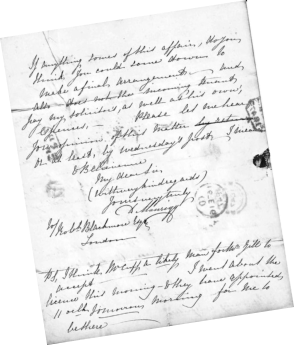


© Palatine Lodge - 1893 - 2023 - In se ipso totus teres -
1847 was an interesting year, the Battle of La Mesa of the Mexican-American War occurred on
January 9, in present-day Vernon, California, the day after the Battle of Rio San Gabriel, Thomas Edison
was born on February 11, in the canal town of Milan, Ohio, the last of seven children. The tragic fate of
the Donner Party came to light later in that month, having spent the winter of 1846-1847 snowbound in
the Sierra Nevada mountains. Alexander Bell was born in Edinburgh on March 3, Jesse James was born
on September 5, and Charlotte Bronte’s novel Jane Eyre was published.
Late in 2018, I was contacted via our Facebook page by Bob Stephens from Shellharbour, New
South Wales, Australia, with a fascinating letter, handwritten on Palatine Hotel notepaper and dated 15th
February 1847. Because of our association with the Palatine Hotel, remember that Palatine Lodge takes
its name from the hotel itself, it’s entirely possible, although I couldn’t find any reference to it, that the
Palatine Bridge that still stands opposite the hotel also takes it’s name from the hotel. Palatine bridge
is a wrought-iron structure which spans the River Irwell opened in 1864 and rebuilt in 1911. Bob
thought that perhaps I might be able to shed some light on the contents of the letter which is
reproduced here, with Bob’s kind permission, written in the style of the period in English Round-
hand Script, more commonly referred to as Copperplate. The letter proved somewhat difficult to
decipher, grateful thanks go to everyone who helped, special thanks to Les Cade and for the final
piece of the puzzle which made sense of the last paragraph, my very good friend Frosty from Australia.
It would help to understand the background to the Palatine Buildings before looking at the
connection with David Maurigy. There is some information available on the internet and it is from various
resources and English Heritage that I have included here relevant information that helps to understand the
relationships between the individual parties referenced in the letter.
Palatine Buildings were formed of three buildings built between 1835 and 1844 on the site of earlier buildings demolished in the 1830s. They were
developed by Robert Gill, General Manager of the Manchester & Leeds Railway Company. Robert Gill features in the David Maurigy letter, which was
written in 1847, three years after the buildings were completed. The south building, opened in 1837-8, housed a livery stables and offices and was
renamed as the Palatine Buildings circa 1840. The middle building is believed to have been constructed at the same time or shortly after, and was used as
offices for the railway company. It was known as the Clowes Building in 1840, but by 1850 it was known as Palatine Buildings. The stables along with the
ground floor of the middle building were replaced by shops circa 1854. The upper floors retained a predominantly office use, but were also used as
assembly rooms and dining rooms, this is where Palatine Lodge would have held their meetings for three years, from 1893 until the move to the Albion
Hotel in 1896. The north building was constructed in 1843-4 as the Palatine Hotel to the designs of local architects, J.P. & I. Holden, and was built by the
firm of David Bellhouse, Manchester building contractors. The hotel opened in 1845 and the first operator was David Maurigy & Co. The author of our
letter was of course David Maurigy,
There were a varied number of businesses that operated out of the Palatine Buildings, amongst the more notable were;
Knowles & Simmons, Wine, Spirit & Ale Merchants Palatine Buildings, 1851;
Wheeler and Wilson Lock-Stitch Sewing Machines, 5, Palatine Buildings, 1862;
George Bromilow, Boot & Shoe Warehouse, 1869;
Henry Tyres, Dealer in Modern and Antique Furniture, 7, Palatine Buildings, 1870
Saunders, Tobacconist, 2, Palatine Buildings, 1888;
Locke & Sons Pianoforte business at 9, Palatine Buildings in 1890;





















